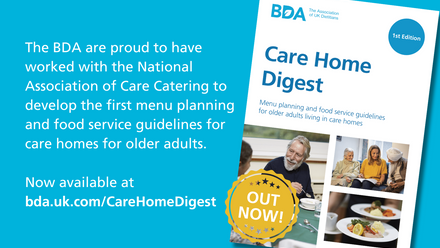
The latest figures from NHS England show that three million, or one in 20, adults are affected by malnutrition. This is currently costing the NHS £20
billion per year.
With the right training, social workers can provide caregivers with the vital support they need, linking them to services to prevent and treat malnutrition. First and foremost, it’s important to identify the signs, which include the following:
- Tiredness and low energy
- Loss of appetite
- Unintentional weight loss
- Clothes, jewellery or dentures becoming loose over time
Malnutrition affects every system in the body and results in increased vulnerability to illness and complications, which can lead to prolonged hospital
stays, more visits to the doctor and, in some cases, death. The main consequences of malnutrition are:
- Fatigue and lethargy
- Falls
- Difficulty coughing, which increases the risk of chest infection
- Heart failure
- Anxiety and depression
- Reduced ability to fight infection
Malnutrition is also associated with several psychological issues. Mental health problems such as depression and anxiety or a change in mental state due to bereavement can affect a person’s appetite and interest in eating. If insufficient nutrients are consumed as a result of this, loss of appetite, a change in mood and energy levels will occur and a negative cycle will ensue.
Given the recent coronavirus pandemic, social isolation is more prevalent than ever among older people and, in particular, amongst those having to
shield. Immobility can significantly reduce appetite in older people and eating alone can also lead to lower than necessary nutritional intake. This, in turn, can contribute to an increased risk of developing malnutrition, or a reduction in the nutritional quality of the food consumed.
Research carried out by Nutrition Journal (1- see references below) explains that eating alone often involves reduced consumption of adequate nutrients, as less fruit and vegetables are consumed. Less thought is also given to selecting the right food when we shop alone, as convenience and haste are deemed more important than a nutritionally balanced diet. The evidence suggests that eating the right food in the right setting increases both mental and
physical wellbeing.
Equally important is the additional element of dining with dignity and the visual appearance of food. For those that live with swallowing difficulties, also known as dysphagia, this can be extremely challenging, as the ability to enjoy eating communally can often prove problematic, especially as we get older. The potential embarrassment and social awkwardness which can accompany the feeling of eating something completely different to everyone else can be hugely debilitating for some. This, in turn, can contribute to an increased risk of developing malnutrition due to a drop in nutritional intake, or a reduction in the nutritional quality of the food consumed.
Some people choose to add liquid to meals and foods when they are home-blending. Whilst this may help achieve the correct texture, it also increases the volume and, depending on the type of liquid used, potentially decreases the nutritional content. People who are living with dysphagia are also at an increased risk of malnutrition2, with one recent study showing that in a large population of older, non-institutionalised adults, dysphagia was significantly and independently associated with malnutrition.3
Buying ready-prepared texture modified meals can provide a solution. Not only is the nutritional content carefully controlled and available to view on
the packaging, but great care is also taken to ensure the meals look appetising – something that can easily be lost when home-blending. When texture modified meals resemble the appearance of regular food as far as possible, it makes it easier for the person with dysphagia to enjoy a meal with friends or family.
Due to the complex nature of malnutrition and its myriad causes, there are no blanket measures to prevent its occurrence. However, once the causes of each case are recognised, there are steps which can be taken to manage, treat and prevent reoccurrence. These steps fall broadly into two categories: clinical and social interventions.
So, once you’ve identified the signs, what are effective dietary solutions for malnutrition? If someone suddenly loses their appetite, becomes thinner, or steadily loses weight unintentionally for a while, it is important to speak to a GP or a dietitian.
For some time now, the treatment for malnutrition has often included the prescription of oral nutrition supplements. However, for dietitians, the preferred first step to treating malnutrition is to encourage a ‘food first approach’ where possible. This is likely to focus on encouraging people to eat higher calorie and protein foods more often.
Taking a food first approach can be seen as a straightforward solution, however increasing food intake for people with a smaller appetite, which is likely to be the case if they have been undernourished, can be challenging. Adding things like a slice of cake, cheese and full fat milk to one’s diet can all be beneficial, as these are energy dense foods. Loss of appetite can be especially common amongst older adults, so smaller and energy dense meals are crucial.
Malnutrition remains one of the most common nutritional challenges among older adults in the UK. Healthcare professionals have a key role to play in the recognition and prevention of this challenging disease, as they often have close and regular contact with older adults in the community. A multidisciplinary (MDT) approach is important for all aspects of care of older people, and this is no different for nutritional care. Regular contact between MDT members can improve nutritional care of older adults, by alerting dietitians, who can treat the individual as necessary.
Anyone who comes into close or regular contact with an older person has the potential to spot some of the signs and symptoms of malnutrition, as outlined above. Remember that weight loss is not an inevitable part of ageing and it is always worth asking an older adult some gentle questions about their dietary intake and any recent, unintentional weight loss if you are concerned.
There are also screening tools that can be completed, the most commonly used one being the Malnutrition Universal Screening Tool (MUST). The MUST is simple to complete with a few details, is useful for identifying if someone is malnourished or at risk of becoming so and can guide toward the appropriate referral to a dietitian.
Whilst a ‘food first’ approach, often with additional use of oral nutritional supplements, is the cornerstone of treatment for malnutrition, there are several key social aspects to consider as well. Simple strategies like attending a local lunch club, encouraging eating with friends or family members or a visit from volunteers from services such as Age UK’s Befriending Service, can all have a positive impact on the amount an older person eats at mealtimes.
When it comes to preventing and treating malnutrition, we should all be thinking of both the clinical and social interventions that can help. Dietitians are best placed to manage malnutrition in the community, although an MDT approach can be the link between identifying more people who are at risk, which can have a positive impact on their wellbeing, overall health and clinical outcomes.
References







